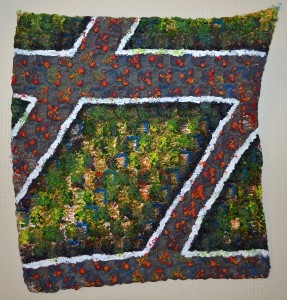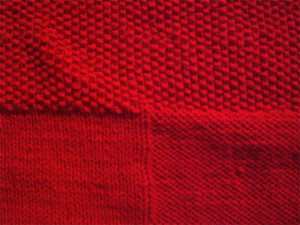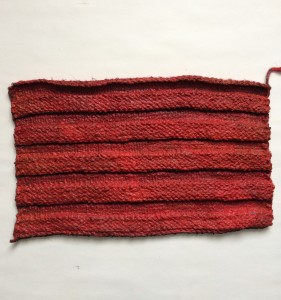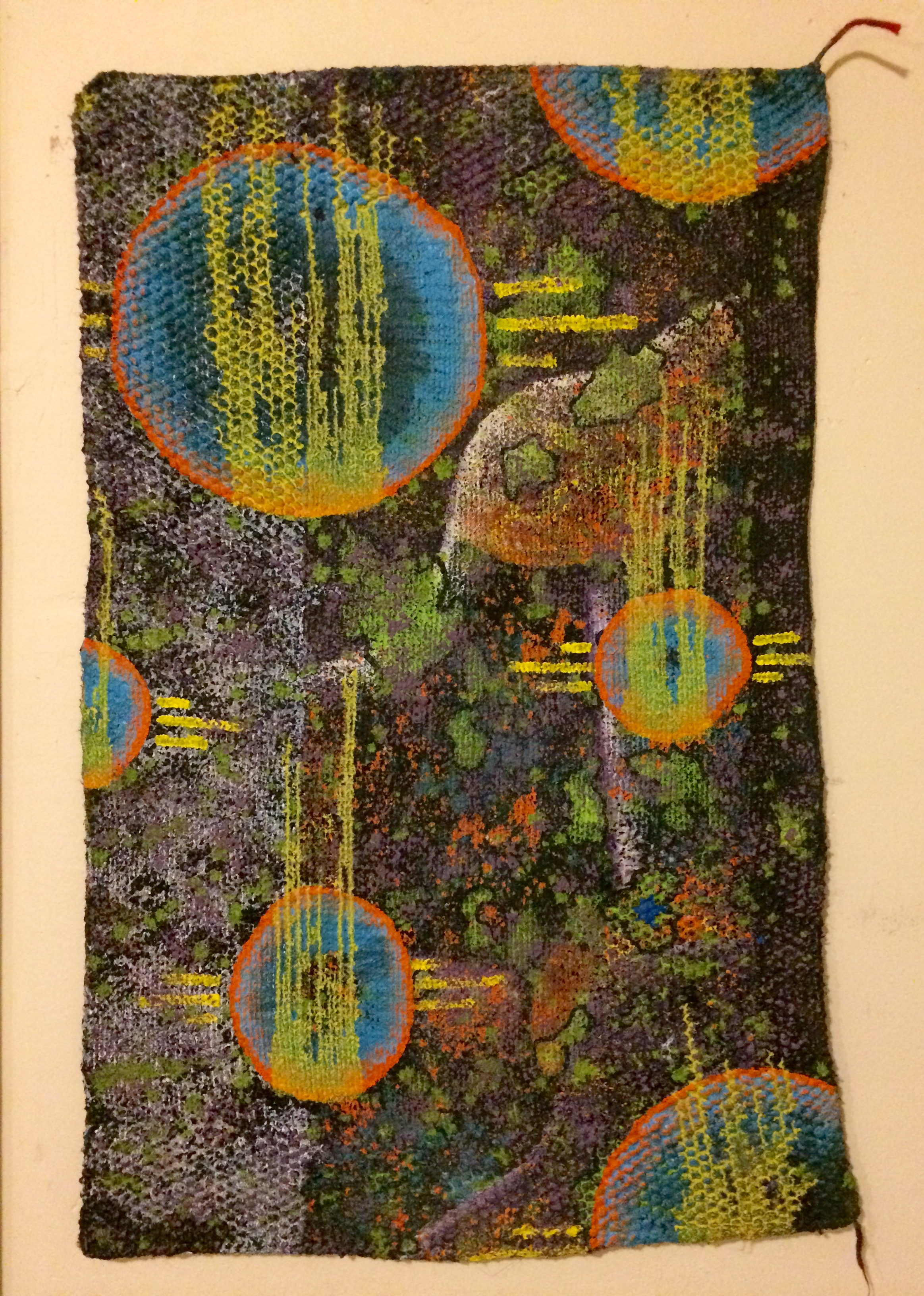Why I Knit My Canvasses
-written by Miranda Aisling
 I knitted my first canvas in early 2011. It was my final semester in college and I was deeply entrenched in creating a series of wall-size abstract oil paintings for my senior show. The first paintings for the show were stretched on traditional canvas but as my scale grew I realized that if I ever wanted to move my artwork I would have to come up with another answer. So I stopped stretching and started staple gunning the treated canvas directly to the wall.
I knitted my first canvas in early 2011. It was my final semester in college and I was deeply entrenched in creating a series of wall-size abstract oil paintings for my senior show. The first paintings for the show were stretched on traditional canvas but as my scale grew I realized that if I ever wanted to move my artwork I would have to come up with another answer. So I stopped stretching and started staple gunning the treated canvas directly to the wall.
Working on these tapestry-like paintings made me appreciate, at a new level, that canvas is just fabric. I had always known this conceptually and even knew the history of oil painting on canvas emerging from the sails of Venice, but I had never thought about canvas as an intentional material. While I stood nose to nose with my eight foot by eight foot paintings, I finally noticed the teensy stitches that constructed the canvas, the same stitches that as a knitter I had been making for years. And so, on a whim, I decided to knit a small square and see what would happen if I painted on it.
This was the birth of my knitted canvas series, which I have now been flirting with and sloughing through for five years. Despite naturally being a connoisseur of many different projects and skills, when it comes to my paintings I am doggedly single-minded. Throughout the past five years of creative experimentation, all of my works have managed to stay in the same recognizable series.
 I first came to the idea of knitted canvasses out of curiosity and procrastination, I was a college student after all. I stuck with it because of economy: knitting canvasses out of super-saver yarn was a cheaper option for a graduate student than buying canvas. Only later did I start to question the concept behind the series. Why was I painting on knitting? What did this combination of materials mean for myself as the artist and for my future audience? Was my immediate gut response, that I like to knit and I like to paint, enough of an answer?
I first came to the idea of knitted canvasses out of curiosity and procrastination, I was a college student after all. I stuck with it because of economy: knitting canvasses out of super-saver yarn was a cheaper option for a graduate student than buying canvas. Only later did I start to question the concept behind the series. Why was I painting on knitting? What did this combination of materials mean for myself as the artist and for my future audience? Was my immediate gut response, that I like to knit and I like to paint, enough of an answer?
As I applied to shows and talked with other artists, I decided it wasn’t and so I started to develop language around the series. I said that my knitted canvasses were a dialogue between the male-dominated art form of abstract oil painting and the female-dominated craft of knitting. This concept appealed to me for two reasons. 1) I was and am a staunch feminist and enjoy playing with the history of gender roles within art. 2) I am trained as a potter and a painter, which means I find myself on both sides of the craft/fine art divide and enjoy using my artwork to bridge said divide.
As I continued to create my knitted canvasses and started to question the concept behind them, I realized that despite any fancy words my finished pieces were not successful as interdisciplinary dialogues. Instead, I was neutralizing the knitting with white gesso and then painting on top of it. I was a painter who used knitting, not a multi-media artist.
Then followed a few years of attempting to push the knitting back into the dialogue. I experimented with clear gesso (which gets cloudy when you use enough layers to stiffen knitting), attempted spray gesso (which captured each and every individual fiber without actually sealing the knitted canvas in a way I could paint on), painted on knitted objects like hats and gloves, left the knitting needles in the canvas, used thicker yarn and more evident textures, and even cut the edges out of a knitted canvas after it had been painted.
Each of these experiments taught me something. Some were successful pieces in their own right, some weren’t, but none of them created the dialogue between knitting and painting that I was describing when I talked about my knitted canvasses. I realized through this experimentation that my painting style is actually quite intricate, sometimes even delicate, and that the more I emphasized the knitting the less I could paint in the style I had been developing.
 Which brings me to last year, when I decided that my knitted canvasses and my traditional canvas paintings just needed to be entirely different series. I had continued my works on traditional stretched canvas this entire time, working on them in tandem with the knitted pieces but now I separated the two and did a series of three knitted sketches where I knitted the piece, neutralized it with white gesso, and then painted it to look like the original knitting. Here it was, finally, an idea that created a true dialogue between the knitting and the painting… and I didn’t like them.
Which brings me to last year, when I decided that my knitted canvasses and my traditional canvas paintings just needed to be entirely different series. I had continued my works on traditional stretched canvas this entire time, working on them in tandem with the knitted pieces but now I separated the two and did a series of three knitted sketches where I knitted the piece, neutralized it with white gesso, and then painted it to look like the original knitting. Here it was, finally, an idea that created a true dialogue between the knitting and the painting… and I didn’t like them.
Although the pieces were strong, they didn’t excite me. And so I finally tabled my concept of a dialogue between knitting and painting, accepting what I have always known, that I am not a fiber artist. Though I have knitted for as long as I can remember, I’ve never enjoyed patterns. I knit purely to move my hands, to watch as something solid and useable grows out of a ball of loose yarn. There is nothing conceptually creative about this process process, only a satisfaction derived from repetitious utilitarian making.
I took this concept of utilitarian knitting and decided that I was going to knit flat, plain canvases that I could use to paint on. No more extreme textures, no threads coming off or any other attempt to acknowledge that the painted surface was knitted. Which returned me to the initial question, why am I knitting my canvasses? Why not just buy regular canvasses? What is it about knitting canvasses that has me so enthralled? What do I want people to see when they look at a finished piece, the knitting or the painting?
My current answer, and who knows how long it will remain, is that the series of knitted canvasses are, first and foremost, paintings. Appropriately so as I am, first and foremost, a painter. There is nothing more inspiring to me than the smell of oils, the consistency of a brush swishing through turpentine, the rich colors squeezing straight out of the tube. But even so, I can’t let go of the knitting.
I revel in the fact that each bump in the knitted canvasses is a handmade knot, although the subtle memory of that process is often only realized when viewed up close. While the laborious process of knitting is only a secondary presence in the finished work, once understood it adds both visual depth and narrative depth to the finished work. The answer to my conceptual musing, at least at present, is that my knitted canvasses are paintings, but they are paintings with a story, or perhaps more accurately, with history.


Pingback: How to knit a canvas painting? - 2 Paintings()